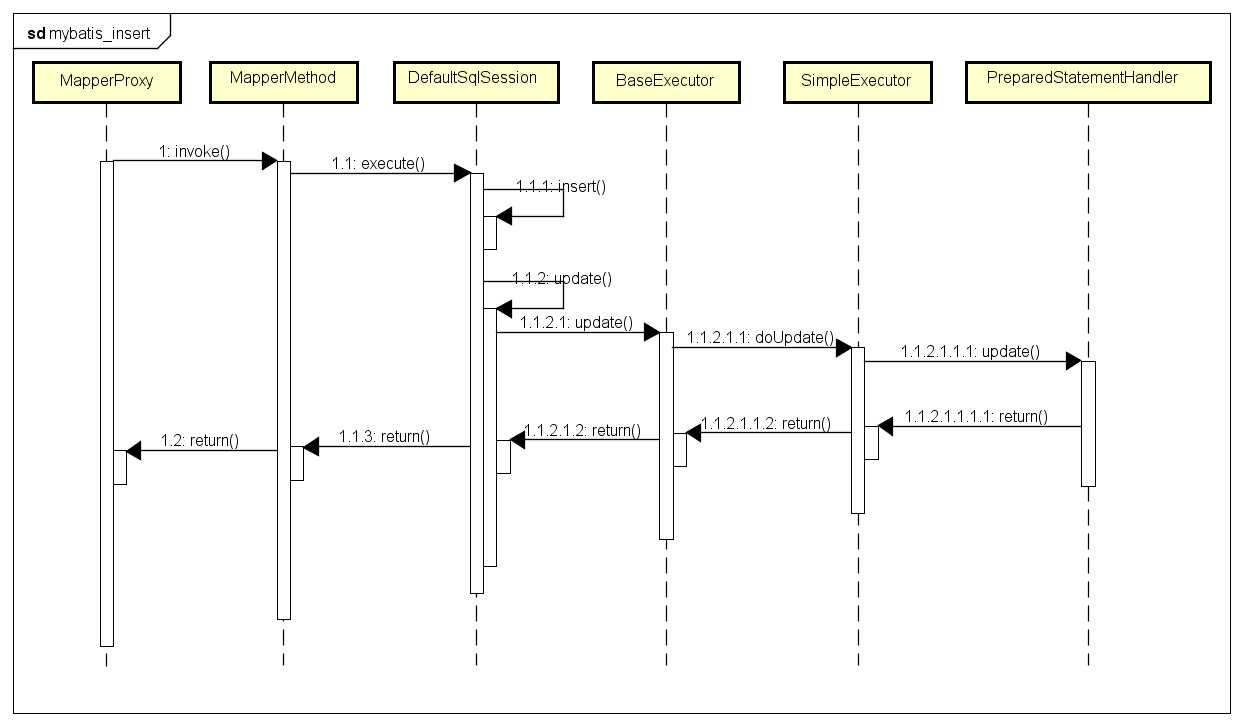使用mybatis注解@Options实现添加记录时返回主键值
Posted
tags:
篇首语:本文由小常识网(cha138.com)小编为大家整理,主要介绍了使用mybatis注解@Options实现添加记录时返回主键值相关的知识,希望对你有一定的参考价值。

官网:http://www.mybatis.org/mybatis-3/index.html
在使用mybatis作为ORM框架时,我通常更喜欢使用注解而非xml配置文件的方式。
业务场景:添加记录之后需要返回自己自增长的主键字段值。
通常,我们会将DAO层写成如下代码(以添加员工Staff为例):
public interface StaffDAO { @InsertProvider(type=StaffProvider.class, method="buildSinleStaff") @Options(useGeneratedKeys=true, keyProperty="staff_id", keyColumn="staff_id") public int addStaff(Staff staff); }
显然,希望在执行addStaff()后返回新添加的员工记录的主键字段值,在这里为staff_id(staff_id为主键字段,且为自增类型)。
但是!!!经过多次验证,依然发现,返回值始终为:1!
跟踪mybatis源码发现,返回值其实是添加的记录数,而不是新加记录的主键字段值,所以永远为1。
mybatis添加记录时序图:
查看org.apache.ibatis.executor.statement.PreparedStatementHandler源码实现:
@Override public int update(Statement statement) throws SQLException { PreparedStatement ps = (PreparedStatement) statement; ps.execute(); int rows = ps.getUpdateCount(); Object parameterObject = boundSql.getParameterObject(); KeyGenerator keyGenerator = mappedStatement.getKeyGenerator(); keyGenerator.processAfter(executor, mappedStatement, ps, parameterObject); return rows; }
显然,返回值是受影响的记录数量,即:添加的记录数。
那么如何才能取得新添加记录的主键字段值呢?继续跟踪源码(org.apache.ibatis.executor.statement.PreparedStatementHandler):
@Override public int update(Statement statement) throws SQLException { PreparedStatement ps = (PreparedStatement) statement; ps.execute(); int rows = ps.getUpdateCount(); Object parameterObject = boundSql.getParameterObject(); KeyGenerator keyGenerator = mappedStatement.getKeyGenerator(); keyGenerator.processAfter(executor, mappedStatement, ps, parameterObject); return rows; }
显然,在执行插入记录操作之后,还执行了如下操作:
Object parameterObject = boundSql.getParameterObject(); KeyGenerator keyGenerator = mappedStatement.getKeyGenerator(); keyGenerator.processAfter(executor, mappedStatement, ps, parameterObject);
在org.apache.ibatis.executor.keygen.Jdbc3KeyGenerator中实现对主键字段的处理:
private void populateKeys(ResultSet rs, MetaObject metaParam, String[] keyProperties, TypeHandler<?>[] typeHandlers) throws SQLException { for (int i = 0; i < keyProperties.length; i++) { TypeHandler<?> th = typeHandlers[i]; if (th != null) { Object value = th.getResult(rs, i + 1); metaParam.setValue(keyProperties[i], value); } } }
恍然大悟!
在使用mybatis注解@Options(useGeneratedKeys=true)获取新添加记录的自增长主键字段值时,需要在执行添加操作之后,直接访问对象的主键字段属性即可取得对应值。
回归到业务代码:
staffService.addStaff(staff); long staffId = staff.getStaff_id(); // 执行添加操作之后获取对象主键字段值
最后需要说明:在mybatis中使用注解实现添加记录时,可以使用@Insert或者@InsertProvider 2个注解,都可以使用@Options注解获取新添加记录的自增长主键字段值。
【参考】
http://isilic.iteye.com/blog/1810782 Mybatis使用:Sql Annotation
以上是关于使用mybatis注解@Options实现添加记录时返回主键值的主要内容,如果未能解决你的问题,请参考以下文章